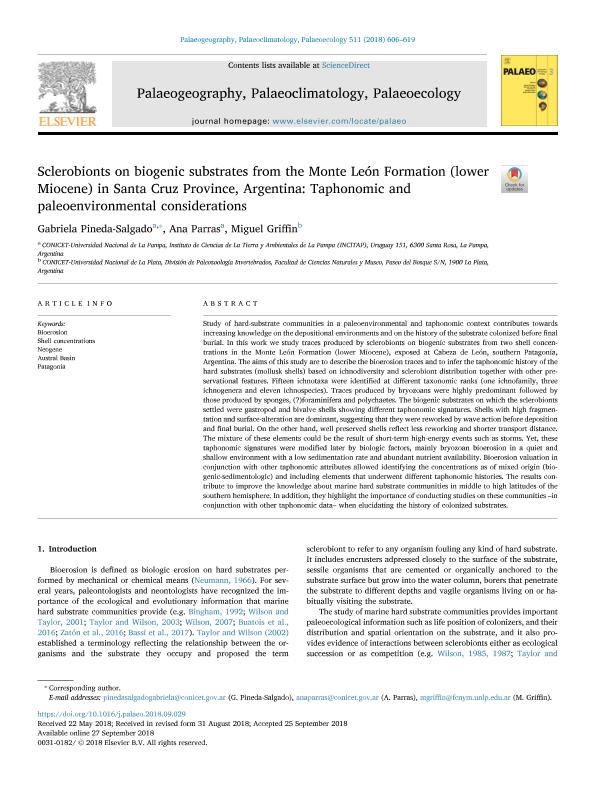Mostrar el registro sencillo del ítem
dc.contributor.author
Pineda Salgado, Gabriela

dc.contributor.author
Parras, Ana Maria

dc.contributor.author
Griffin, Miguel

dc.date.available
2019-09-05T20:19:31Z
dc.date.issued
2018-12
dc.identifier.citation
Pineda Salgado, Gabriela; Parras, Ana Maria; Griffin, Miguel; Sclerobionts on biogenic substrates from the Monte León Formation (lower Miocene) in Santa Cruz Province, Argentina: Taphonomic and paleoenvironmental considerations; Elsevier Science; Palaeogeography, Palaeoclimatology, Palaeoecology; 511; 12-2018; 606-619
dc.identifier.issn
0031-0182
dc.identifier.uri
http://hdl.handle.net/11336/83000
dc.description.abstract
Study of hard-substrate communities in a paleoenvironmental and taphonomic context contributes towards increasing knowledge on the depositional environments and on the history of the substrate colonized before final burial. In this work we study traces produced by sclerobionts on biogenic substrates from two shell concentrations in the Monte León Formation (lower Miocene), exposed at Cabeza de León, southern Patagonia, Argentina. The aims of this study are to describe the bioerosion traces and to infer the taphonomic history of the hard substrates (mollusk shells) based on ichnodiversity and sclerobiont distribution together with other preservational features. Fifteen ichnotaxa were identified at different taxonomic ranks (one ichnofamily, three ichnogenera and eleven ichnospecies). Traces produced by bryozoans were highly predominant followed by those produced by sponges, (?)foraminifera and polychaetes. The biogenic substrates on which the sclerobionts settled were gastropod and bivalve shells showing different taphonomic signatures. Shells with high fragmentation and surface-alteration are dominant, suggesting that they were reworked by wave action before deposition and final burial. On the other hand, well preserved shells reflect less reworking and shorter transport distance. The mixture of these elements could be the result of short-term high-energy events such as storms. Yet, these taphonomic signatures were modified later by biologic factors, mainly bryozoan bioerosion in a quiet and shallow environment with a low sedimentation rate and abundant nutrient availability. Bioerosion valuation in conjunction with other taphonomic attributes allowed identifying the concentrations as of mixed origin (biogenic-sedimentologic) and including elements that underwent different taphonomic histories. The results contribute to improve the knowledge about marine hard substrate communities in middle to high latitudes of the southern hemisphere. In addition, they highlight the importance of conducting studies on these communities –in conjunction with other taphonomic data– when elucidating the history of colonized substrates.
dc.format
application/pdf
dc.language.iso
eng
dc.publisher
Elsevier Science

dc.rights
info:eu-repo/semantics/openAccess
dc.rights.uri
https://creativecommons.org/licenses/by-nc-sa/2.5/ar/
dc.subject
Austral Basin
dc.subject
Bioerosion
dc.subject
Neogene
dc.subject
Patagonia
dc.subject
Shell Concentrations
dc.subject.classification
Paleontología

dc.subject.classification
Ciencias de la Tierra y relacionadas con el Medio Ambiente

dc.subject.classification
CIENCIAS NATURALES Y EXACTAS

dc.title
Sclerobionts on biogenic substrates from the Monte León Formation (lower Miocene) in Santa Cruz Province, Argentina: Taphonomic and paleoenvironmental considerations
dc.type
info:eu-repo/semantics/article
dc.type
info:ar-repo/semantics/artículo
dc.type
info:eu-repo/semantics/publishedVersion
dc.date.updated
2019-09-04T20:04:55Z
dc.journal.volume
511
dc.journal.pagination
606-619
dc.journal.pais
Países Bajos

dc.journal.ciudad
Amsterdam
dc.description.fil
Fil: Pineda Salgado, Gabriela. Consejo Nacional de Investigaciones Científicas y Técnicas. Instituto de Ciencias de la Tierra y Ambientales de La Pampa. Universidad Nacional de La Pampa. Facultad de Ciencias Exactas y Naturales. Instituto de Ciencias de la Tierra y Ambientales de La Pampa; Argentina
dc.description.fil
Fil: Parras, Ana Maria. Consejo Nacional de Investigaciones Científicas y Técnicas. Instituto de Ciencias de la Tierra y Ambientales de La Pampa. Universidad Nacional de La Pampa. Facultad de Ciencias Exactas y Naturales. Instituto de Ciencias de la Tierra y Ambientales de La Pampa; Argentina
dc.description.fil
Fil: Griffin, Miguel. Universidad Nacional de La Plata. Facultad de Ciencias Naturales y Museo. División Paleozoología Invertebrados; Argentina. Consejo Nacional de Investigaciones Científicas y Técnicas; Argentina
dc.journal.title
Palaeogeography, Palaeoclimatology, Palaeoecology

dc.relation.alternativeid
info:eu-repo/semantics/altIdentifier/url/https://www.sciencedirect.com/science/article/pii/S0031018218304577
dc.relation.alternativeid
info:eu-repo/semantics/altIdentifier/doi/https://doi.org/10.1016/j.palaeo.2018.09.029
Archivos asociados
